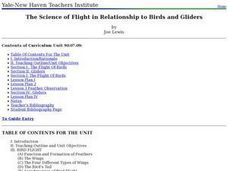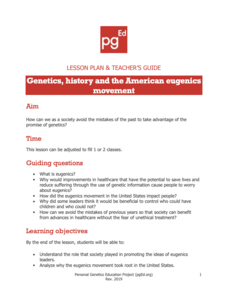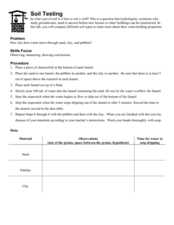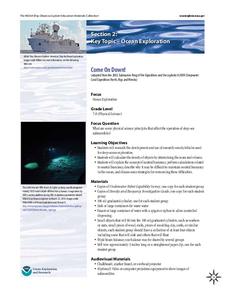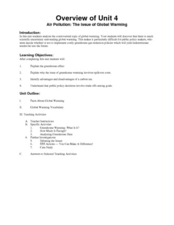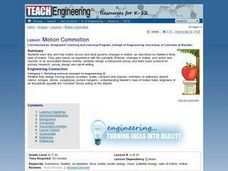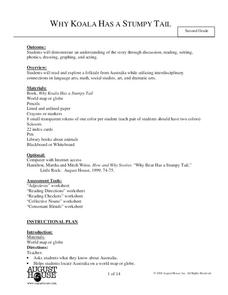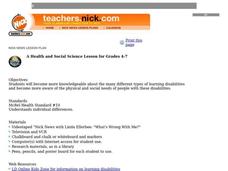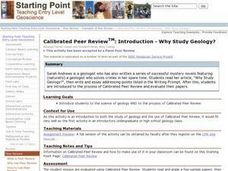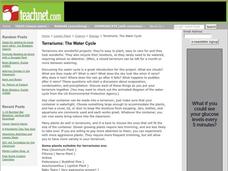Curated OER
The Science of Flight in Relationship to Birds and Gliders
Students study man's first form of flight which truly imitated the free-flight of birds--the glider. They examine such important contributions to the invention of the glider, such as Sir George Cayley, Jean Marie LeBris, Otto Lilienthal...
Curated OER
Beyond Science?: New Energy Age
Students explore, examine, experiment and study the energy believed to exist in the vacuum of space called zero-point energy. They design and build a machine and then place their machines to test zero-pointed energy into a competition.
Curated OER
Vaccines--How and Why?
Twelfth graders study the history, progression and current uses for vaccines in the prevention of disease. They simulate an epidemic and experiment with pathogens.
Personal Genetics Education Project
Genetics, history and the American Eugenics Movement
A poignant 20-slide show introduces high schoolers to the amazing accomplishments of genomics and raises the question of eugenics. This lesson is only for mature audiences, as it deals with rape and other sensitive topics, but it is...
Curated OER
The Extinction and Rediscovery of the Ivory-Billed Woodpecker
An incredibly thorough, and well-designed lesson teaches youngsters about the presumed extinction and rediscovery of the ivory-billed woodpecker in Arkansas. Learners discuss the environmental factors that led to the birds disappearance....
Columbus City Schools
Cell-abrate!
Lights, camera, action! With the cell at center stage, guide your seventh grade biologists through the tiny drama that plays out within every living thing. Then, enjoy the show as they portray the organelles they've studied—a performance...
Curated OER
Soil Testing
Earth science learners experiment with the water-holding properties of sand, pebbles, and clay. They apply their findings to the building of a well. This activity is engaging and tactile, and it demonstrates the importance of considering...
NOAA
Come on Down!
What do we do when a dive is too dangerous for humans to accomplish? Send in the robots! Middle school scientists get acquainted with several different models of submersible robots in the second lesson of six from NOAA. Lab groups then...
Curated OER
Air Pollution: The Issue of Global Warming
Here is an outstanding 10-page lesson plan on global warming. Learners discover that there is a lot of controversy surrounding this topic in that the science behind global warming is difficult to prove. The best thing about this plan is...
Odyssey of the Mind
Odyssey of the Mind Curriculum Activity: Making of a Monster
Over the course of a week, the class will study how monsters are portrayed throughout literature. But why? Monsters in science fiction or horror often depict the darker side of human nature; they are described for their horrific physical...
Curated OER
Technology-Lesson 2-Resolving Issues
Students define resolution. They explain the relationship between probe size and resolution and explain why information in three dimensions is necessary to describe the structure of an object. Research technology to the study of Cellular...
Curated OER
Science: Motion Commotion
Young scholars examine Newton's three laws of motion to discover what causes it and how it changes. They conduct motion experiments by building catapults and constructing balloon rockets. Finally, they conduct peer studies correlating...
Curated OER
Why Koala Has a Stumpy Tail
Second graders explore Australian folktales. In this folktales lesson plan, 2nd graders gain knowledge about Australia and it's animals by reading books and discussion. Students find the adjectives in the book and write what they...
Curated OER
HEALTH & SOCIAL SCIENCE
Students create a three part poster entitled, "Learning Disabilities". The first two parts are two paragraph reports on any two of the learning disabilities featured in the discussion. The final part of the poster is a two paragraph essay.
Curated OER
Studying Seafloor Spreading on Land
In this seafloor spreading instructional activity, students review the processes taking place along the mid-ocean ridges. This instructional activity has 3 short answer questions.
Shmoop
ELA - Literacy.CCSS.ELA-Literacy.RST.9-10.6
Key to understanding scientific or technical texts is identifying the underlying question the author is attempting to answer. Provide your young scientists with an opportunity to practice identifying these questions and the procedures...
Curated OER
Module 2: "Keeping Teeth Bright and Healthy"
Students become aware why cleaning their teeth helps keep them strong and healthy. They study basic brushing techniques, what plaque is, how a cavity is formed, why having clean teeth is an important part of having a clean body and why...
Curated OER
Perched Parrot Decorative Chair
Learners discuss the rainforests and why they are important to the Earth's environment. They study the habitats and characteristics of various animals that live in rainforests. Students build a decorative chair using a rainforest theme.
National Academy of Sciences
Genetic Disease: Putting DNA to Work
Scientific knowledge of genetic information has grown quickly over the last decade. An interactive lesson has learners research the role of science and medicine in diagnosing and treating genetic disorders. They consider the job of the...
Curated OER
Periodic Table of Fun
Are you looking to put the fun back in the fundamentals of chemistry? Why not have groups create their own periodic tables of something (animals, food, music groups, etc.) practicing the organizational strategies used in the periodic...
Curated OER
Calibrated Peer Review: Introduction-Why Study Geology?
Young scholars read an article written by Sarah Andrews, a geologist who has written mystery novels featuring a geologist who solves crimes. After reading the article, students write an essay based on a Writing Prompt and begin peer...
Curated OER
Why Study War?
Students discuss war, specifically World Wars I and II, analyze causes and element of war, and decide whether war is acceptable solution to conflict situations, given resulting loss that occurs.
Curated OER
Forest Canopies: View from the Top
Students examine the economic and ecological benefits of forest canopies. They read and discuss an article, answer questions, conduct research, draw field sketches of a canopy ecosystem, conduct a feasibility study, or prepare tourist...
Curated OER
The Water Cycle
Students create terrariums in containers in order to study the Water Cycle. They examine how the terrarium maintains life in the closed environment.
